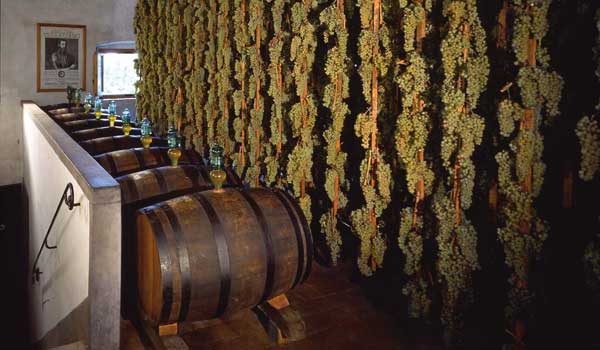
In Tuscany it is common to end a meal by soaking almond-studded cantuccini cookies in glasses of a Tuscan dessert wine, Vin Santo. To the producers of the finest Vin Santos, this seems as ridiculous as dropping an oyster into the bottom of the flute of Veuve Cliquot before taking a sip. Why taint a lovely wine with cookie crumbs?
Historically considered to be the wine of friendship and hospitality, Vin Santo has been enjoyed in Tuscany for centuries. The finest has a deep, beautiful, straw color and has scents of hazelnut, vanilla and sweet oak with accents of apricot and lychee fruit. It is based on varieties of white wine grapes, but to bear the quality-assuring DOC label, however, the blend must consist of at least 70% Trebbiano and Malvasia.
Though the origin of its name is not clear, legend has it that during the 1449 Ecumenical Council in Florence, the head of the Greek Orthodox Church sampled a glass and exclaimed, “Ma questo è vino di Xantos!” (But this is wine of Xantos!), comparing it to the fine wines of “Xantos,” his hometown in Greece. According to another version, it is “Santo” because the grapes are harvested close to the Feast of All Saints (Nov. 1) and crushed the following year at the beginning of Lent.
For a wine estate, producing a good Vin Santo is a task requiring patience and perseverance. Individual bunches are hung to dry in specially prepared, well-ventilated rooms. Partially dehydrating ripe, flavorful grapes increases the concentration of natural sugars, which then yields higher alcohol content during the fermentation process—Vin Santo can contain as much as 17% alcohol.
Once the sweet juices have been extracted, they are aged for three to five years in oak or chestnut barrels in cool, dark, underground cellars. The cold temperature slows the fermentation and creates velvety textures and rich, sumptuous flavors. Barrels that once contained scotch and whiskey produce a “liquor-y” effect, while the finest French barriques are known to draw out the Vin Santo’s natural vanillins and tannins.
There is a wide spectrum of individual personalities within the Vin Santo family, which, unfortunately, can create problems for the consumer. While a good Vin Santo can be close to divine, cheap ones are inevitably overly sweet. Avoiding a supermarket purchase and seeking advice and shopping in a reputable enoteca (wine shop) can help in steering clear of lesser-quality brands.
Small wineries often produce great wines, but because of the high cost of producing good Vin Santo, as well as the expertise, time and space required, some of the larger vineyards with familiar names—Verrazzano, Avignonesi — can actually be a better bet. The San Giusto a Rentannano and Fontodi estates also consistently craft delicious Vin Santo with the character and finesse to serve as the glorious end of a Tuscan meal.
Our suggestion: try several until you find one you like best. Just remember to save your biscotti for your cappuccino.








